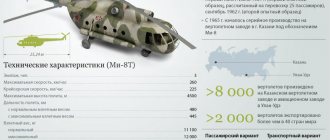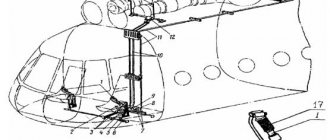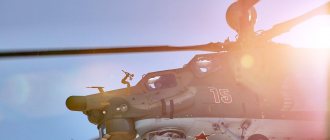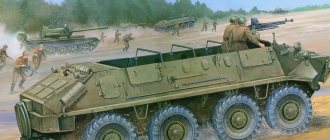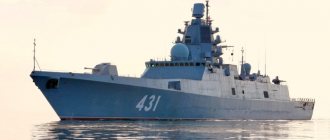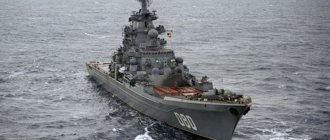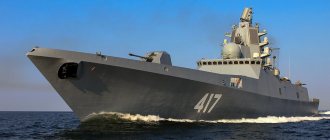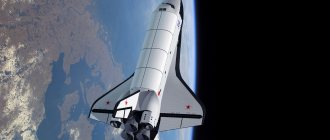The two main Russian helicopter manufacturing schools - Mil and Kamova - since last year have become a single National Helicopter Manufacturing Center named after. M. L. Mil and N. I. Kamov (JSC “NTsV Mil and Kamov”).
“Russian Helicopters” explained the merger by the potential for the development of design bureaus (design bureaus), but instead of “carefully preserving” two unique production facilities, the absorption of the Kamov Design Bureau by the Milevsky management team, which came to manage Russian Helicopters, is in full swing. Funding for Kama projects and research is steadily being curtailed. Meanwhile, it is with Nikolai Kamov’s design bureau that the history of Russian helicopter manufacturing begins, the future of which is now under threat.
One of the main helicopter manufacturing schools is losing funding.
Mi-8 helicopter
Initially, a unit of this series was designed as a multi-purpose military vehicle. However, the Russian Army's modernized helicopters (Mi-8MTV-2) have long served as a long-range strike force. Representatives of the series gained great popularity in the role of landing transport. Mi-8 is the most common helicopter in Russia. They were the main striking units in hot spots in Afghanistan, Chechnya, Algeria, Angola, Vietnam, Egypt, Iraq, Congo, Libya, Pakistan, Syria, Uganda and many other countries.
The development of Mi-8 helicopters began in the spring of 1960. The prototype of the series was the legendary piston Mi-4. For a long time the device did not find its proper place of application. However, in 1991, unexpectedly, a number of countries ordered a massive purchase of the Mi-8. About 3,000 units were exported. A few years later, the Mi-8 acquired a new modernized version of the MTV-2. Its configuration included 4 B8V20-A blocks with 20 automatic magazines each, 9 machine guns, 4 GSh-23L cannons and a suspension for mounting aerial bombs weighing up to 500 kg. The helicopter is capable of rising to a height of 4.5 km, reaching speeds of up to 250 km/h and withstanding a load of 4000 kg. Thanks to two 1500 hp engines. With. and a spacious interior, the vehicle can accommodate up to 28 paratroopers.
Long road to heaven
The history of the new rotorcraft dates back to the late 1980s, when the Mi-4 helicopter for cargo transportation weighing about 2 tons became obsolete and the niche remained empty. In the early 90s, the Kamov Design Bureau began developing a new army helicopter labeled B-60, which later became known as the Ka-60. To increase the flight speed, the Kamov team for the first time, instead of their traditional coaxial design, used a tail rotor, which was made in a closed annular channel.
Ka-60 helicopter
Image source: © Vitaly Belousov/TASS
However, in 2010, the Ministry of Defense decided to suspend the project, and part of the reconnaissance and combat functions of the Ka-60 was transferred to the Ka-52 model (known as the “Alligator”). It was decided to place a bet on the civilian version of this helicopter - the Ka-62.
Test pilot 1st class Nail Azin flew all Kamov aircraft. On the Ka-62 - from the first flights. The total flight time is more than three thousand hours, of which about two thousand are test hours. “On the Ka-62, it’s even difficult to answer, there are two hundred hours,” he admits. — In the second half of 2022, very intensive work and flights began. The Ka-62 is a new generation machine, everything inside is completely new, there is very little in common with the Ka-60, except that the appearance is similar.”
The Ka-60 project was suspended, however, the strategy of the Russian Helicopters holding company provides for joint work with the Ministry of Defense of the Russian Federation to resolve the issue of import substitution of components of the Ka-62 helicopter. Together we discuss the missions he must carry out. Therefore, in the future it can be used in the interests of the Ministry of Defense of the Russian Federation Andrey Semenov, First Deputy Managing Director - Technical Director of Arsenyevskaya Aviation named after. N.I. Sazykina
In 2010, the Russian Helicopters holding company resumed the project in a civilian version - the Ka-62, although it retained a number of design features from its predecessor, still underwent many changes. The load capacity increased to 2 tons in the cabin and 2.5 tons on the suspension; French Ardiden 3G with a power of 1680 hp began to be used as engines. There are now five main rotor blades - one more than in the Ka-60. Also, the Ka-62 implements the “glass cockpit” principle, when all important information and instrument readings are displayed on screens.
The active stage of the project began in 2012 with the presentation of a model of an updated helicopter design at the international helicopter industry exhibition HeliRussia in Moscow. At the end of May 2022, the Ka-62 made its first test flight at the Arsenyev Airlines site.
The first prototype of the Ka-62 helicopter during a flight at the Arsenyevsk Aviation Test Station named after N.I. Sazykina, 2022
Image source: © Russian Helicopters Press Service/TASS
Serial production was planned to begin in 2020, however, during preliminary tests at certain speeds, dynamic instability of the helicopter arose. “As a result, it was necessary to make significant modifications to the helicopter - to move part of the tail from the keel to the tail boom. This solution turned out to be effective, and the helicopter was dynamically brought to the parameters required by the technical specifications,” Dmitry Bezdetko, director of the Ka-62 project at Arsenyev Aviation, told TASS.
According to him, during tests on this helicopter it was possible to reach a speed of 315-316 km/h. “It took four months to finalize the tail, which ensured the confident achievement of such a speed, from receiving the draft design documentation to testing. New parts were manufactured, technological development was carried out, the machine was modified and put into operation,” he explained.
As part of the development work, Progress produced five Ka-62 fuselages, three of which are flightable. One (prototype No. 2) is located at the enterprise, the others (No. 3 and No. 4) are on the territory of the National Helicopter Manufacturing Center “Mil and Kamov” in the Moscow region.
Assembling the Ka-62 helicopter in the assembly shop of the Arsenyev Aviation Aviation named after N.I. Sazykina
Image source: © Yuri Smityuk/TASS
“Flight tests are currently underway, the total number of flights completed is 210 out of 365 planned. Leader vehicle No. 2 has 240 flight hours. Certification factory tests are planned to be completed in September 2022, at which time we will switch to the SKI (certification control tests) program,” Bezdetko said.
“We are now working to obtain a type certificate and a manufacturer’s certificate for civil helicopter equipment in 2022,” said the technical director of Progress.
Mi-24 helicopter
This rotorcraft was called the “crocodile”. Russian Air Force helicopters of the Mi-24 series have repeatedly confirmed their ability to conduct round-the-clock combat. This device can not only parachute up to 10 people, it is very effective in air and ground attacks. The Mi-24PS model is an alternative to the original and is capable of performing search and rescue missions. Another representative of the series, the Mi-24РХР, has found wide application in radiochemical reconnaissance. It was these helicopters that made it possible to timely assess the level of danger during the liquidation of the disaster at the Chernobyl nuclear power plant.
The aircraft's arsenal includes suspended weapons (2 cannons, 2 machine guns and 2 grenade launchers), Sturm, Hermes and Ataka guided missiles. The package also contains cassettes with bombs up to 500 kg. The upgraded version has an air-to-air cannon weapon. The maximum speed limit is 330 km/h. The lift ceiling is 5 km. The total engine power is 4400 hp. With.
The era of gyroplanes
At the age of 25, Nikolai Kamov entered the design bureau of the famous aircraft designer D.P. Grigorovich, which was engaged in experimental naval aircraft construction. Here Kamov became interested in the idea of a rotary-wing aircraft, in which he saw many advantages. Information about machines with a main rotor is being collected bit by bit and on a proactive basis.
Together with colleague N.K. Skrzhinsky in 1929, Kamov created the first Soviet gyroplane - an aircraft that uses a rotor freely rotating in autorotation mode to create lift. During the creation of the KASKR "Red Engineer" gyroplane, Kamov meets student Mil.
The first flight of the rotorcraft became possible thanks to the enthusiasm of all participants in the work, the support of Osoaviakhim and the general atmosphere of interest in aviation in the country. The creation of the first gyroplane laid the foundations for helicopter manufacturing in the USSR and formed the first specialists in this field.
In 1931, Kamov went to work at the Central Aerohydrodynamic Institute (TsAGI), where he worked exclusively with helicopters. At TsAGI, Kamov heads a team that, on instructions from the military, is developing a two-seater A-7 gyroplane designed for reconnaissance and fire adjustment. In 1934, the car took off for the first time.
The A-7 became the first combat gyroplane in the world and the first production rotorcraft in the USSR. During the Great Patriotic War, a squadron of five A-7 aircraft took part in combat missions. Autogyros, due to their ability to take off almost vertically, were very useful for use in the forests of the Smolensk region.
Mi-28 helicopter
"Night Hunter" is a universal assault weapon for domestic aviation. Russian Mi-28 combat helicopters are capable of gliding equally well day and night, both at high altitudes and at low altitudes (up to 5 meters). They have excellent flight characteristics, thanks to which they can detect and destroy the desired targets in the shortest possible time. One of the advantages of the device is its high protection against anti-aircraft weapons. Experts compare Russian Mi-28 helicopters with American AH-64 Apache combat units. It is worth noting that the former not only have a better navigation system, but also a much more accurate guided missile launcher. The Mi-28 arsenal includes a large-caliber 2A42 cannon, 4 NAR with a set of 20 S-8 units, as well as an S-13 NAR. ATGMs of the “Ataka”, “Sturm” and “Strelets” series are used as guided missile launchers. MAX speed – up to 300 km/h. Flight altitude – up to 5.8 km. GTE power – 4400 hp. With.
From "Black Shark" to "Alligator"
A separate page in the history of Kamov is the creation of a fundamentally new combat helicopter. By the end of the 70s, the Mi-24 helicopter ceased to meet the changing requirements of combined arms combat. The concept of a universal infantry fighting vehicle helicopter, which could not only carry out strikes, but also transfer a squad of paratroopers from place to place, was considered obsolete. There was a division into combat and transport-combat helicopters. In the United States, development of the AH-64 Apache attack helicopter was already in full swing.
The response of the Kamov Design Bureau was the proactive development and creation of a new attack helicopter, the Ka-50. After the successful defense of the draft design and layout, the first model of the Ka-50 helicopter was built in May 1981. It made its first flight on June 17, 1982. It was a truly revolutionary car. Firstly, this is the first single-seat combat helicopter in the world. Before this, it was believed that a pilot was not capable of simultaneously piloting and fighting. Secondly, the Ka-50 was the first in domestic aviation to receive fully composite propeller blades. To improve the aerodynamic characteristics of the helicopter, retractable landing gear and an aircraft-type fuselage were used. In addition, for the first time in the helicopter industry, a standard pilot ejection seat was installed here. The helicopter received the nickname “Black Shark”.
The appearance of the “Black Sharks” coincided with the collapse of the USSR. Massive cuts in the military budget began. Ka-50 helicopters were produced literally one by one. A total of 15 Ka-50 Black Shark helicopters were built, including test vehicles.
A dark era has begun for the Russian defense industry. The military order shrank to a meager financial trickle, which did not allow not only to purchase new types of equipment and weapons, but even to maintain the serviceability of existing ones. Hundreds and thousands of planes, helicopters, tanks, and ships were written off for scrap metal. Design bureaus and factories were closed and sold off for markets, offices and trade. He found his own recipe for survival in the catastrophic years of the 90s - he decided to focus on modernizing the existing global fleet of Ka helicopters. Hundreds of Ka machines operated successfully in various regions of the planet, and the demand for reliable, inexpensive helicopters was high. Kamovtsy modernized the civilian version of the Ka-32 to meet customer requirements. And over the next decade and a half, 13 modifications of this helicopter were created, sold to a dozen countries. Demand for them especially increased after the Ka-32A11BC modification was certified in 1998 in Canada.
All this allowed Kamov not only to survive and maintain production - in Arsenyev, but also to continue work on its promising combat helicopter. Thus was born the Ka-52 “Alligator” - an improved version of the Ka-50. From his predecessor, he inherited the power plant, wing, load-bearing system, tail, landing gear, tail and middle parts of the fuselage. The main difference is that a second crew member appeared, which made the car more reliable. In addition, all-weather capability was implemented - the ability to work in any weather conditions and at any time of the day.
Ka-52 Alligator helicopter during training flightsPhoto: Vitaly Timkiv/TASS
The Ka-52 has a much happier fate. The government finally remembered the army. The modernization of the Armed Forces and a large rearmament program began. Money was also found to purchase Alligators. As of January 1, 2022, the Russian Air Force had 90 such helicopters in service, and in total, by 2022, the military should receive 146 Ka-52 multi-purpose attack helicopters. Combat testing in Syria showed the high effectiveness of the Alligators, which have become a threat to terrorists.
With the advent of a combat helicopter among the Kamovites, a rivalry arose between “Kamov” and “Mil”, which lasted for decades. But now the long disputes and rivalries are behind us. And if not behind, then they are not externally manifested in any way. Now helicopter companies are neighbors across the road and even share a site for finished equipment, which is also a take-off site. Another era. And two excellent combat vehicles, the Mi and the Ka, are successfully serving in the army.
Mi-35 helicopter
This rotorcraft is the best modification of the Mi-24. These Russian helicopters are widely used not only in the Russian Federation, but also in a number of other countries, such as Afghanistan, Iraq, Myanmar, Brazil, Indonesia, Peru, Venezuela, etc.
The Mi-35 series is designed for the destruction of heavy armored vehicles, landing and fire support of ground forces. Often a helicopter is used to transport cargo or the wounded. One of the main modifications of the series was night tracking devices capable of recognizing targets at a distance of up to 4.2 km. The combat kit includes 2 cannon mounts, 4 suspensions, 10 guided missiles, containers with mines and bombs. The helicopter is capable of rising to a height of up to 4.5 km at a maximum speed of 340 km/h. Passenger capacity – up to 8 people. Includes 2 engines of 2200 hp. With.
Design Features
The new helicopter became a logical continuation and development of the Ka-25. The traditional coaxial twin-screw design was driven by two TVZ-117KM gas turbine engines, which were located in the front part of the fuselage. The power of each engine was 2200 l/s, which was twice as much as the old GTD-3F gave. The engines were started through the operation of an autonomous AI-9 turbocharger. The supply of aviation kerosene was 4.7 tons, which significantly increased the helicopter’s flight range. The power supply of the new helicopter has increased by 1.7 times compared to similar parameters of the Ka-25.
Two three-bladed main rotors had folding blades - an innovation that allows aircraft to be compactly placed on the deck of aircraft-carrying ships and in the hangar. Fiberglass was used to make blades. The fuselage of the vehicle itself is made according to a beam-stringer design and is all-metal. The casing is made of lightweight duralumin sheets mounted on a metal frame.
The longitudinal stability of the helicopter during flight was ensured by the presence of a tail unit consisting of two fins. In general, this design of the fuselage and propulsion contributed to the necessary stability of the vehicle during flight, which was important in strong crosswinds and rough seas. Acceptable meteorological and hydrological parameters are as follows:
- side wind up to 20 m/s;
- lateral roll 8°, longitudinal pitch 2°.
The rotorcraft is equipped with four fixed landing gear supports, which, thanks to the presence of a hydraulic system, can lift the fuselage of the vehicle for convenient access to the cargo compartment.
The forward part of the fuselage is the cockpit, where the pilot and navigator are located next to each other. The main radar workstation is located directly under the bottom of the cabin. From the outside it is covered by a translucent fairing. The cargo compartment is located in the middle part of the fuselage. Under the bottom there is a compartment for the main anti-submarine weapons. In the aft part of the fuselage there is a compartment for a hydroacoustic station - the main working tool of an anti-submarine helicopter. The search and rescue version does not have this equipment. The helicopter is equipped with a cargo winch, which allows lifting and lowering cargo and evacuating people from hard-to-reach places.
To provide additional buoyancy, the helicopter body has special inflatable equipment on the sides. During an emergency landing on water, the air balloons are filled with air within 4-5 seconds.
Pilots have at their disposal quite modern navigation equipment that allows them to fly at night and in conditions of poor, limited visibility. The autopilot, in combination with navigation equipment, ensures precise arrival at the drop point of the necessary sonar or rescue equipment. The vehicle is capable of hanging in the air at a given height for a long time, which gives a more accurate picture of the sonar horizon when working with a sonar station.
To perform its main function - detecting and destroying enemy submarines, the Ka-27 has the following equipment and weapons:
- sighting and search system "Octopus";
- AT-1MV anti-submarine torpedo;
- depth bombs with a caliber of 50-250 kg;
- There are technical conditions for the external suspension of APR-2E anti-submarine missiles.
The Octopus system is the heart of the machine, since with its help the helicopter can perform its main combat functions. Thanks to advanced radio and hydroacoustic equipment, and the presence of an information and computing complex, enemy submarines can be detected over a wide area, up to 1500 square meters. miles.
Ka-25 helicopter
This is one of the main anti-submarine combat units of domestic aviation. Russian military helicopters of the Ka-25 series are capable of detecting targets under water at a distance of up to 250 km. The device achieved such impressive results thanks to the new “Initiative” radar system of the “2K” and “Poplavok” models. In addition, the specialized equipment includes 2 frequency stations and a magnetometer. The development of these systems has been carried out over several decades. The helicopter's armament kit consists of 4 or 8 bomb launchers of the PLAB and OMAB series and 2 AT-1 torpedo launchers. The device is capable of reaching speeds of 220 km/h with a ceiling height of 3.5 km. This is a very heavy and massive helicopter (up to 7200 kg), but it is distinguished by its maneuverability and level of take-off speed. The kit includes 2 engines of 990 hp. With. The cabin can accommodate up to 8 soldiers.
Helicopters of Kamov Design Bureau
On April 14, 1953, the Ka-15 multi-purpose helicopter took to the skies for the first time, which became the first mass-produced helicopter created at the Nikolai Ilyich Kamov Design Bureau. In the future, this design bureau repeatedly proved its worth and the merits of the chosen scheme. A signature feature of Kamov's machines was the use of a coaxial screw arrangement. Now, more than 60 years later, Kamov Design Bureau vehicles are a formidable and effective weapon of the Russian armed forces, capable of performing even unusual military tasks. The first sign - Ka-15
Experimental Design Bureau - 2 (OKB-2), headed by the talented designer Nikolai Ilyich Kamov, one of the founders of the domestic school of helicopter engineering, was created on October 7, 1948. In the future, it was first renamed the Ukhtomsky Helicopter Plant (UVZ), and in 1974 it was given the name of the chief designer. Initially, this design bureau specialized in creating helicopters for the Soviet navy. For many years, the hallmark of this design bureau was the coaxial propeller arrangement, which made it possible to create highly maneuverable and well-controllable rotorcraft, while maintaining the small dimensions of the equipment.
The first success of the design bureau can be safely called the Ka-15 helicopter, which, according to NATO codification, received the somewhat offensive designation “Chicken”. It was this two-seat shipborne helicopter that became the first Kamov Design Bureau machine, which was produced in a large series. A total of 354 of these helicopters were built. The new aircraft made its first flight on April 14, 1953. It was lifted into the air by test pilot Dmitry Efremov.
The development of the Ka-15 helicopter was carried out in the early 50s of the last century. The helicopter model was approved by the military at the end of 1951. Designed for placement on a ship, the Ka-15 helicopter was a very compact machine. It was almost twice as long as the Mi-1 helicopter. At the same time, the designers had to work to accommodate all the necessary equipment in such a small volume.
Comparative military tests of the Mi-1 helicopters (single-rotor design with a tail rotor) and Ka-15 (coaxial design), by decision of the naval leadership, were carried out on board the cruiser Mikhail Kutuzov. Thanks to its high maneuverability and small size, Kamov’s helicopter could successfully take off and land from a small ship’s platform even in conditions of force six seas. While the Mi-1 helicopter, which had a long tail boom and tail rotor, was significantly limited in operation from the ship's deck. It could not be used when the ship was rocking and there was turbulence in the air flow. The results of the tests carried out on the cruiser "Mikhail Kutuzov" finally convinced the Soviet sailors that a coaxial design was necessary for ship-based helicopters.
At the same time, the flight performance characteristics of the Ka-15 helicopter obtained during testing exceeded the design ones. A small helicopter with a pilot and passenger on board could carry a load of 210 kg with a take-off weight of 1410 kg and an engine power of 280 hp. At the same time, the Mi-1 helicopter could carry 255 kg of cargo on board with a vehicle weight of 2470 kg and engine power of 575 hp. At the same time, the controllability characteristics that were characteristic of a coaxial helicopter and the compactness of the Ka-15 helicopter made it possible to take off/land from very limited areas.
The helicopter began to enter service with the Navy combat units in 1957. But due to its small carrying capacity, the Ka-15 was ineffective as an anti-submarine helicopter. Thus, one helicopter could only carry 2 sonar buoys intended for tracking submarines. In this case, the control equipment was on another helicopter, and the means of destroying submarines (depth charges) were on a third. Also, the operation of the new vehicle in the fleet was accompanied by various problems that indicated the low reliability of the Ka-15: flutter of the main rotor was noted, as well as oscillations of the “Earth resonance” type during taxiing.
In July 1960, one of these helicopters, belonging to the 710th separate helicopter aviation regiment, crashed due to the blades clashing after taking off from the Novonezhino airfield. In November, a similar incident happened again, but then the helicopter was able to land. These two cases were not the only ones. In May 1963, helicopters completely stopped flying in the USSR Navy, where new helicopters and airplanes were ready to replace them. DOSAAF and Aeroflot operated these machines until the 1970s. They were used to train cadets along with the Mi-1. The helicopter was also used in agriculture to pollinate crops.
Flight characteristics of the Ka-15: Crew - 1 person. Number of passengers - 1 person or 300 kg of cargo. Overall dimensions: length - 6.26 m, height - 3.35 m, main rotor diameter - 9.96 m. Empty weight - 968 kg. Maximum take-off weight - 1460 kg. Engine power - 1x280 hp. Maximum speed is 155 km/h. Practical range - 278 km. Practical ceiling - 3500 m.
Anti-submarine helicopter Ka-25 and ship-based multi-purpose helicopter Ka-27
An important milestone in the fate of the Kamov Design Bureau was the Ka-25 helicopter. This helicopter became the key to the development of the design bureau and Russian naval aviation as a whole. Becoming the first domestically designed combat helicopter. The Ka-25 helicopter was intended to combat nuclear submarines of a potential enemy. To successfully solve the tasks assigned to it and ensure flights over directionless water surface, the Ka-25 helicopter was the first in the world to install an all-round radar. Ka-25 helicopters faithfully served in the navy for about 30 years.
The Ka-25 anti-submarine helicopter made its first flight on May 20, 1961. The car was lifted into the sky by test pilot D.K. Efremov. The first production models of the helicopter were built in 1965 at a helicopter plant located in the city of Ulan-Ude. These machines marked the beginning of the successful operation of Ka-25 helicopters in the fleet. It was the Ka-25 that became the first domestic combat helicopter and remained so until 1969. This year, the Mi-24 army combat helicopter was created in the USSR.
The Ka-25 helicopter was built according to a twin-rotor coaxial design and had two powerful gas turbine engines; the helicopter landing gear was four-legged. The fuselage of the Ka-25 was all metal. The main focus of the helicopter was the fight against enemy submarines. Therefore, its armament consisted of an AT-1 anti-submarine homing torpedo or 4-8 depth charges weighing from 50 kg to 250 kg. In addition, the helicopter had a cassette with radio-acoustic buoys, which was also suspended in its weapons compartment. This compartment was equipped with doors that could be opened using electric drives.
The Ka-25 helicopter became an excellent rotorcraft that completely suited military sailors. In our country, Ka-25 helicopters were in service until 1991, and Ka-25Ts (target designation helicopter) until the mid-90s. In total, 18 different versions of this machine were created for different purposes. From 1965 to 1973, about 460 Ka-25 helicopters of all modifications were assembled in Ulan-Ude.
Flight characteristics of the Ka-25: Crew - 2 people. Number of passengers - 1 anti-submarine weapon operator or 12 passengers. Combat load - 1100 kg of bombs or torpedoes. Overall dimensions: length - 9.75 m, height - 5.37 m, main rotor diameter - 15.74 m. Empty weight - 4765 kg. Maximum take-off weight - 7500 kg. Engine power - 2x1000 hp. Maximum speed is 220 km/h. Practical range - 650 km. Practical ceiling - 4000 m.
A logical continuation of the successful design was the next generation combat multi-purpose shipborne helicopter - the Ka-27. At the same time, the effectiveness of Soviet anti-submarine defense increased significantly with the advent of this helicopter. On the basis of the Ka-27 helicopter, new helicopter systems were built in the interests of the Navy: the Ka-27PS search and rescue helicopter, the Ka-29 amphibious landing and fire support helicopter, the Ka-31 radar patrol helicopter and many others.
The first prototype of the future Ka-27 helicopter took to the skies on August 8, 1973, and on December 24 of the same year it made its first circular flight. Serial production of the new shipborne helicopter began in 1977 at the helicopter plant in the city of Kumertau. For various reasons, development of the helicopter continued for 9 years. The helicopter was accepted into service with the USSR Navy only on April 14, 1981. The helicopter has not yet been removed from service. Currently, it is the only Russian anti-submarine helicopter. There are more than 80 of these machines in service, and a total of 267 Ka-27 helicopters of various modifications were assembled.
The Ka-27 helicopter was designed according to the traditional design for the Kamov Design Bureau using two three-bladed counter-rotating rotors. The fuselage of the car was all metal. Structurally, the helicopter consists of a fuselage, a load-bearing system, a control system, a power plant and take-off and landing devices. To combat enemy submarines, AT-1MV anti-submarine torpedoes, APR-23 missiles and free-falling anti-submarine bombs (SSBNs) of 50 kg or 250 kg caliber could be used.
Flight characteristics of the Ka-27: Crew - 3 people. Number of passengers - 3 operators or 3 passengers or 4000 kg of cargo in the cabin or 5000 kg on an external sling. Combat load - 2000 kg of bombs, torpedoes or missiles. Overall dimensions: length - 12.25 m, height - 5.4 m, main rotor diameter - 15.9 m. Empty weight - 6100 kg. Maximum take-off weight - 12000 kg. Engine power - 2x2225 hp. Maximum speed is 290 km/h. Practical range - 900 km. Practical ceiling - 5000 m.
From “Black Shark” (Ka-50) to “Alligator” (Ka-52)
By the mid-70s of the last century, the main combat helicopter in the Soviet Union was the Mi-24, the “old man” remains in service today, but even then the leadership of the country’s Ministry of Defense had the opinion that this machine did not fully meet army requirements. The helicopter, which was created according to the concept of a “flying infantry fighting vehicle” and, if necessary, could conduct not only assault operations, but also transfer a squad of paratroopers from place to place, paid for this with a slight decrease in its combat qualities. In addition, the Soviet military received information about the development and testing of new attack helicopters in the United States (we were talking about the AH-64 Apache attack helicopter).
The response to this was the creation of a new attack helicopter, which was commissioned to be developed by the Kamov Design Bureau. After successfully defending the draft design and layout, the first model of the Ka-50 helicopter was built in May 1981. The aircraft made its first flight on June 17, 1982, the next year after the adoption of the very successful Ka-27. The Ka-50 became no less a masterpiece of the Kamov team, although it did not receive a real start in life. The Ka-50 was a full-fledged attack helicopter, which was designed to destroy enemy personnel and armored vehicles on the battlefield, as well as various enemy engineering structures.
It was a twin-engine, single-seat combat helicopter with coaxial propellers. The Ka-50 received a straight wing of relatively high aspect ratio and developed vertical and horizontal tail surfaces. To improve the aerodynamic characteristics of the helicopter, a retractable landing gear was used. The Ka-50 used an aircraft-type fuselage with a fairly wide use of aluminum alloys and composite materials. Also among the features of the new helicopter was the pilot rescue system, which was based on the K-37-800 rocket-parachute system produced by NPP Zvezda. For a helicopter, such a system was new. It allowed the pilot to safely eject in a speed range from 0 to 400 km/h and an altitude of 0 to 4 thousand meters. The ejection was carried out by shooting off the rotor blades and shooting off the upper part of the helicopter's cockpit canopy.
The use of composite materials, which accounted for approximately 30% of the total weight of the structure, made it possible to reduce the weight of individual elements of the helicopter by 20-30% compared to metal counterparts. The reliability and survivability of the vehicle was also increased. Thanks to new materials, the service life of individual airframe components was increased by 2-2.5 times. And the labor intensity of producing complex helicopter structural elements has decreased by 1.5-3 times.
Ka-50 helicopters were produced individually in a very small series. The last vehicles were handed over to the military in 2009. A total of 15 Ka-50 Black Shark helicopters were built, including test vehicles. All of them are assigned to the 344th Center for Combat Use and Retraining of Army Aviation Flight Personnel, while some of the vehicles have already been decommissioned, and some are used as training aids. In many ways, the helicopter became famous thanks to the feature film “Black Shark”, in which it played a major role. But don’t think that this car has sunk into oblivion. For the Kamov Design Bureau, the helicopter became an invaluable experience, which made it possible to test new technologies in practice. In the future, this experience was fully implemented in the new multi-purpose attack helicopter Ka-52 Alligator.
The Ka-52 multi-role attack helicopter has a much more successful fate. As of January 1, 2015, the Russian Air Force had 72 such helicopters in service; by 2022, the military should receive 146 Ka-52 multi-purpose attack helicopters. The main difference between this vehicle and the Ka-50 was the appearance of a second crew member and the full ability to work in any weather conditions and at any time of day. Initially, the Ka-50 was not intended for night combat.
The two-seat modification of the “Black Shark” was 85% unified with the Ka-50 helicopter. From its predecessor, the Alligator inherited the power plant, wing, support system, tail, landing gear, tail and middle parts of the fuselage. Their main difference is the new front part in the form of a two-seater cabin, in which the Alligator crew members were placed side by side. The cabin is also equipped with K-37-800 ejection seats. The instrumentation of the cockpit has also been seriously updated, where liquid crystal displays have appeared instead of traditional electromechanical indicators.
The appearance of a second pilot relieved the crew, making the car more reliable. The Ka-52 not only added an operator-navigator, but also chose a non-standard cockpit layout. Typically, two crew members in attack helicopters are positioned in tandem, one behind the other. But on the Ka-52, the crew members sit shoulder to shoulder. At the same time, the helicopter control handles are available both on the right and on the left. This arrangement of the helicopter crew had its advantages. For example, increased coherence between pilots was achieved, and there was no need to install a second instrument panel.
The electronic components of the machine have also changed significantly. The highlight of the helicopter is the RN01 “Crossbow” radar, which was created by Phazotron-NIIR engineers. Serial production of this radar began in 2011. The “crossbow” is capable of simultaneously tracking up to 20 different targets. At the same time, the system is able to detect a tank at a distance of 12 km, an enemy attack aircraft - 15 km, and a Stinger missile - 5 km. But that’s not all, this radar warns the crew when approaching obstacles such as power line wires within 500 meters. In this case, the error in determining the distance to the target does not exceed 20 meters, and the angular error does not exceed 12 minutes. The Arbalet radar serves the navigation and sighting systems of the Ka-52, and also participates in the organization of missile defense and warns the crew about dangerous weather conditions and obstacles.
The first flight of the Ka-52, converted from the production Ka-50 helicopter, took place on June 25, 1997. Serial production of the helicopter began on October 29, 2008 at, located in the city of Arsenyev. A series of state tests of the Ka-52 helicopter ended in 2011. That same year, in May, the first combat vehicles entered service with the combat units of the country's army aviation.
The new generation Ka-52 Alligator combat reconnaissance and attack helicopter is designed to combat enemy tanks, armored and unarmored vehicles, enemy personnel, as well as enemy helicopters at the front line of confrontation and in the tactical depth. The helicopter can be used at any time of the day and in any weather conditions. Also, Ka-52 helicopters are able to conduct target reconnaissance, carry out target distribution and hardware target designation of combat helicopters and ground forces command posts interacting with them. The helicopter is capable of accompanying military convoys and providing fire cover for the landing force, and patrolling the area.
Flight characteristics of the Ka-52: Crew - 2 people. Combat load - 2000 kg on 4 hardpoints. Armament - 30-mm 2A42 cannon (600 rounds), 4x3 ATGM "Vikhr" or 4 UR "Igla-V" or 80x80-mm NUR or 10x122-mm NUR, as well as containers with machine-gun and cannon weapons. Overall dimensions: length - 14.2 m, height - 4.9 m, main rotor diameter - 14.5 m. Empty weight - 7800 kg. Maximum take-off weight - 10400 kg. Engine power - 2x2400 hp. Maximum speed is 300 km/h. The maximum rate of climb at sea level is 16 m/s. Practical range - 460 km. Practical ceiling - 5500 m.
Sources of information: https://www.airwar.ru https://svpressa.ru https://www.russianhelicopters.aero/ru/kamov Materials from free sources
Ka-29 helicopter
This model is a multi-purpose model with the possibility of upgrading to a shock version. Recently, such Russian helicopters have been designed purely for hitting targets on the ground and landing. They became widespread in China, Vietnam and India.
The Ka-29 arsenal includes an aiming system, up to 90 aircraft and anti-tank missiles, 2 or 3 cannon installations. It is possible to attach 4 heavy machine guns. The interior of the rotorcraft can accommodate up to 16 paratroopers or 6 stretchers with wounded. Load capacity – up to 4000 kg. Rated engine power is 4400 hp. With. The maximum speed that the Ka-29 helicopter can reach with an average load is 280 km/h. As for the ceiling height, it is 4.3 km.
Ka-50 helicopter
This model received the unofficial name “Black Shark”. Russian military helicopters of the Ka-50 series were developed in parallel with the Mi-28. The designers' task was to create a destructive machine that would demonstrate its superiority not only in the air, but also during a ground attack.
The first helicopter models turned out to be too heavy and clumsy, so it was decided to reduce the weight of the armor and the dimensions of the device due to a single-seat layout. Due to the high cost, the production of “Black Sharks” until recently could not be called rapid. By 2007, the Air Force had only 25 vehicles of this series in its arsenal. The Ka-50's armament includes 3 cannons and 7 missile launchers. Among the controlled automatic configurations, it is worth highlighting the ATGM series “Vikhr” and “Igla” (2 pieces each). The bomb arsenal is represented by a whole warehouse of charges (FAB, KMGU, ZB, RBC and others). The maximum dive speed is up to 350 km/h. Maneuverability height – 4 km. GTE power – 2x2200 l. With.
Ka-52 helicopter
The second name of the model is “Alligator”. These new Russian helicopters are the pride of domestic military aviation. They are capable of hitting any targets at a distance of up to 15 km. All thanks to the universal search and targeting system integrated into the Vikhr anti-tank missiles. This makes the Gators the favorites in any air or ground battle. In addition, the Ka-52 is equipped with a radar system called “Crossbow”. It not only increases the combat capability of the vehicle, but also makes it possible to detect missiles flying in the direction of the helicopter at a distance of up to 5 km.
The Ka-52 arsenal includes the 2A42 cannon and the Sturm, Vikhr, and Igla ATGMs. There are 4 S-8 or S-13 missile launchers. The speed threshold is up to 300 km/h at the maximum level of controllability. The height ceiling is up to 5.5 km. Maximum engine power is 2700 hp. With.
Tempered by Primorye
As the first deputy managing director - technical director of Arsenyevskaya Aviation named after. N.I. Sazykina Andrey Semenov, the Ka-62 has the ability to be autonomously based and hangar-free. Operation from base airfields, oil platforms, and unpaved sites is also possible.
A special feature of the helicopter is the use of polymer composite materials (PCM) in its design - fiberglass, carbon fiber, organoplastic, as well as high-strength modern aluminum, titanium alloys and steel. “The volume of PCM structures on a helicopter has been increased to 60% by weight, which increases speed, maneuverability and payload capacity, and also reduces fuel consumption,” says Semenov, adding that now the whole world is moving in this direction and “we are not lagging behind here.” from the global helicopter industry."
The Ka-62 design is designed for use in a wide range of climatic and geographical conditions at temperatures from -50 to +45 °C. “In July in the Primorsky Territory the temperature outside is +32 in the shade, and in the sun if you hang a thermometer, it will reach +50. Humidity is about 80% - this is considered the norm for the summer; in winter it, of course, drops, says Bezdetko. — In winter, we carried out tests at -24, and launched at -30 in the morning. That is, we tested quite complex temperature conditions.” Thus, the Ka-62 is being prepared for export around the world and for operation in the most difficult climatic conditions.
Assembling the Ka-62 helicopter in the assembly shop of the Arsenyev Aviation Aviation named after N.I. Sazykina
Image source: © Yuri Smityuk/TASS
Another advantage of the machine, according to the project director, is the design with a tail rotor in an annular channel, used for the first time in the domestic helicopter industry. “Firstly, it is safety for the personnel, for those who maintain and operate the helicopter. Secondly, noise is reduced, and the propeller in the ring improves controllability, that is, the air flow created is more powerful, which allows for better control of the helicopter,” he notes.
The head of the Progress workshop for parts and assemblies made of composite materials, Ivan Grishenko, told how the enterprise, known for the production of the famous Ka-52 combat helicopters, is mastering the production of new civilian equipment. “More than 60% of the fuselage consists of parts made of composite materials, and these parts are quite voluminous and large. That is, literally six large panels assemble the helicopter fuselage. In the Ka-52, parts are on average one meter per meter in size, while the Ka-62 is seven meters long and two and a half wide,” he notes. — That is, assembly is faster and easier, there are fewer joints. This gives the helicopter strength and reduces weight.”
As for other innovations in the production of the Ka-62, the plant has mastered new equipment. If until now we worked on metal (aluminum), now we use composite. “First, a master model is made that completely follows the contour of the helicopter. Fabric is laid out on it, impregnated by infusion, which then hardens. We peel it off, and we get such a “crust” on which we already lay out the main part. It’s very convenient for repairs, and if something has changed structurally, adjustments can be made much faster, easier and cheaper,” says Grishenko. — We applied the same method when we mastered the production of parts for the Mi-171A3 helicopter (the helicopter is manufactured jointly with the Ulan-Ude Aviation Plant and the Kazan Helicopter Plant - TASS note). We make side panels (doors, hatches), and canopy. Fully composite materials, which are not used on either the Ka-52 or the Ka-62; the technologies are slightly different.”
Assembling the Ka-62 helicopter in the assembly shop of the Arsenyev Aviation Aviation named after N.I. Sazykina
Image source: © Yuri Smityuk/TASS
At MAKS 2021, the United Engine Corporation presented the VK-1600V demonstrator engine for the Ka-62 helicopter. According to plans, the engine will be overhauled at UEC-Klimov and by the end of the third quarter of 2022 the engine will be ready for the first tests.
“Currently, an import substitution program is being carried out on this helicopter. First of all, import substitution of engines and transmissions is envisaged. There are plans to equip the Ka-62 helicopter with the VK-1600V engine upon completion of development work and certification of this engine. According to the plan, its certification will be completed within three years,” says Progress technical director Semenov.
